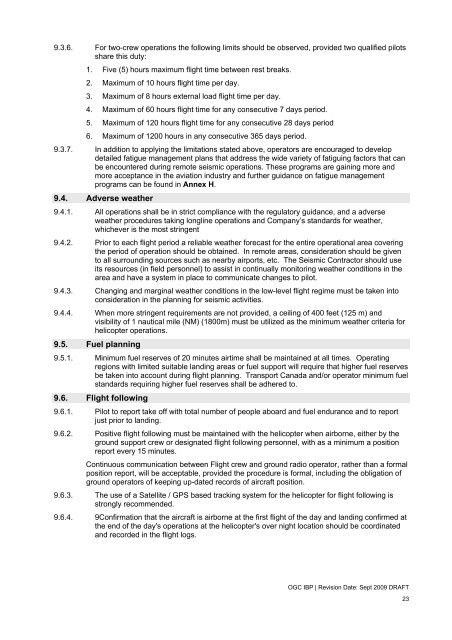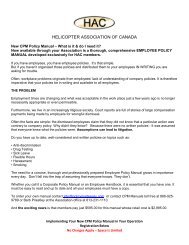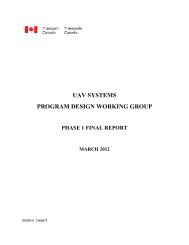HAC Oil & Gas IBP - Helicopter Association of Canada
HAC Oil & Gas IBP - Helicopter Association of Canada
HAC Oil & Gas IBP - Helicopter Association of Canada
You also want an ePaper? Increase the reach of your titles
YUMPU automatically turns print PDFs into web optimized ePapers that Google loves.
9.3.6. For two-crew operations the following limits should be observed, provided two qualified pilotsshare this duty:1. Five (5) hours maximum flight time between rest breaks.2. Maximum <strong>of</strong> 10 hours flight time per day.3. Maximum <strong>of</strong> 8 hours external load flight time per day.4. Maximum <strong>of</strong> 60 hours flight time for any consecutive 7 days period.5. Maximum <strong>of</strong> 120 hours flight time for any consecutive 28 days period6. Maximum <strong>of</strong> 1200 hours in any consecutive 365 days period.9.3.7. In addition to applying the limitations stated above, operators are encouraged to developdetailed fatigue management plans that address the wide variety <strong>of</strong> fatiguing factors that canbe encountered during remote seismic operations. These programs are gaining more andmore acceptance in the aviation industry and further guidance on fatigue managementprograms can be found in Annex H.9.4. Adverse weather9.4.1. All operations shall be in strict compliance with the regulatory guidance, and a adverseweather procedures taking longline operations and Company’s standards for weather,whichever is the most stringent9.4.2. Prior to each flight period a reliable weather forecast for the entire operational area coveringthe period <strong>of</strong> operation should be obtained. In remote areas, consideration should be givento all surrounding sources such as nearby airports, etc. The Seismic Contractor should useits resources (in field personnel) to assist in continually monitoring weather conditions in thearea and have a system in place to communicate changes to pilot.9.4.3. Changing and marginal weather conditions in the low-level flight regime must be taken intoconsideration in the planning for seismic activities.9.4.4. When more stringent requirements are not provided, a ceiling <strong>of</strong> 400 feet (125 m) andvisibility <strong>of</strong> 1 nautical mile (NM) (1800m) must be utilized as the minimum weather criteria forhelicopter operations.9.5. Fuel planning9.5.1. Minimum fuel reserves <strong>of</strong> 20 minutes airtime shall be maintained at all times. Operatingregions with limited suitable landing areas or fuel support will require that higher fuel reservesbe taken into account during flight planning. Transport <strong>Canada</strong> and/or operator minimum fuelstandards requiring higher fuel reserves shall be adhered to.9.6. Flight following9.6.1. Pilot to report take <strong>of</strong>f with total number <strong>of</strong> people aboard and fuel endurance and to reportjust prior to landing.9.6.2. Positive flight following must be maintained with the helicopter when airborne, either by theground support crew or designated flight following personnel, with as a minimum a positionreport every 15 minutes.Continuous communication between Flight crew and ground radio operator, rather than a formalposition report, will be acceptable, provided the procedure is formal, including the obligation <strong>of</strong>ground operators <strong>of</strong> keeping up-dated records <strong>of</strong> aircraft position.9.6.3. The use <strong>of</strong> a Satellite / GPS based tracking system for the helicopter for flight following isstrongly recommended.9.6.4. 9Confirmation that the aircraft is airborne at the first flight <strong>of</strong> the day and landing confirmed atthe end <strong>of</strong> the day's operations at the helicopter's over night location should be coordinatedand recorded in the flight logs.OGC <strong>IBP</strong> | Revision Date: Sept 2009 DRAFT23









